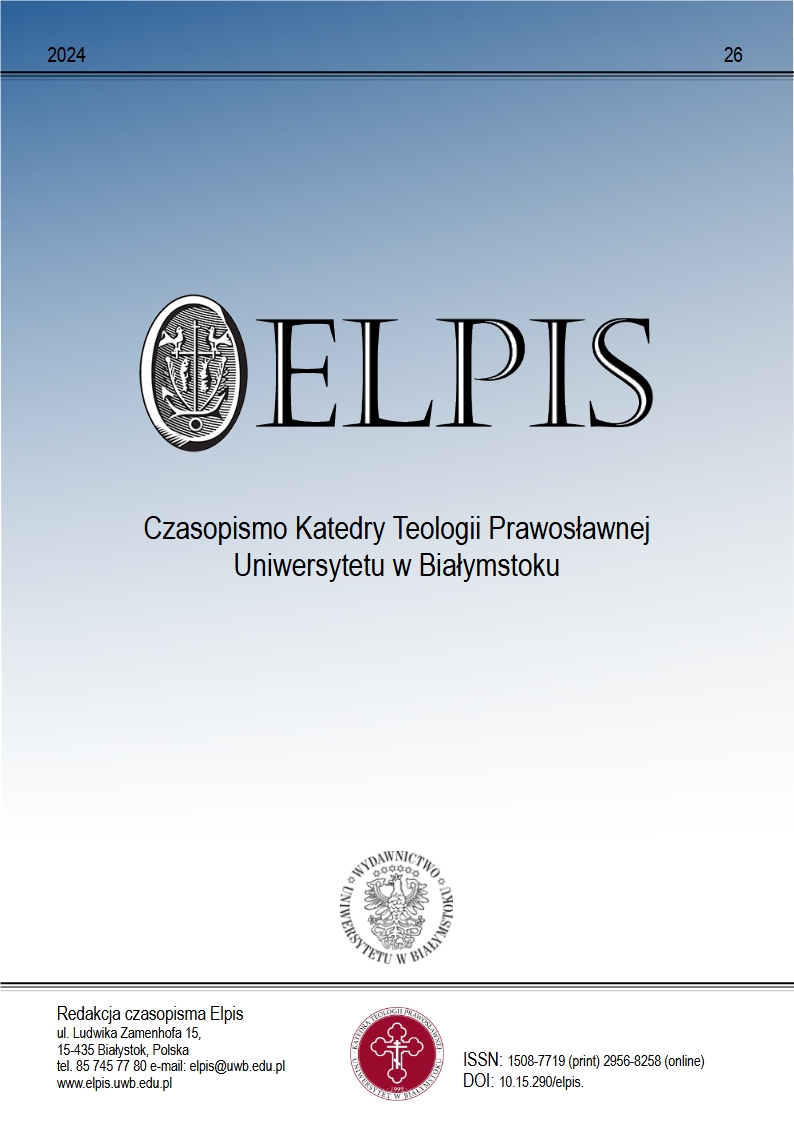„Do this in memory of me!” Eastern versus Western understanding of the eucharistic anamnesis
DOI:
https://doi.org/10.15290/elpis.2024.26.12Keywords:
Anaphora, anamnesis, Divine Liturgy, Eucharist, Eastern liturgyAbstract
The concept of liturgical anamnesis refers to the remembering of God's acts, which makes them present and actualised in every celebration. Both Latin and Orthodox theology emphasise the anamnetic dimension of liturgical celebration. However, there are important differences between individual liturgical practices and their theological understanding. This article attempts to explore the nature and extent of these differences. Are these merely different formulations due to distinct liturgical traditions and practices, or do the differences concern the essence of the understanding of the Eucharist as a memorial? In order to answer this question, the first part of this article will discuss the biblical understanding of the concept of anamnesis, which is common to both Latin and Eastern theology. This will be done using the historical-genetic method. In the second part, the understanding of anamnesis in the Latin Church will be presented as it results from an analysis of the Eucharistic Prayers used by that Church. For this purpose, the author will employ the method of analysis and interpretation of liturgical texts. The third part will attempt to characterise the Orthodox theology of anamnesis.
Downloads
References
Botte, B. (1954). Problèmes de l’Anamnèse. The Journal of Ecclesiastical History, 1(5), s. 16-24.
Czerski, J. (1998). Boska liturgia św. Jana Chryzostoma. Wprowadzenie liturgiczno-biblijne do liturgii eucharystycznej Kościoła Wschodniego, Opole: WT UO.
Dahl, N.A. (2008). Anamnesis: Mémoire et commemoration dans le christianisme primitif. Studia Theologica - Nordic Journal of Theology, 1-2(1). 69-95. https://doi.org/10.1080/00393384708599652.
Haroutiounian-Thomas, G. (2005). L’anamnese et l’historire du salut dans les anaphores de la famille syrienne occidentale. W: Mélanges liturgiques offerts à la mémoire de l’archevêque Georges Wagner (1930-1993) (s. 113-126). Paris.
Jan Paweł II. (2003). Ecclesia de Eucharistia.
Święta Kongregacja Obrzędów (1976). Instrukcja o kulcie tajemnicy eucharystycznej Eucharisticum Mysterium.
Kunzler, M. (1999). Liturgia Kościoła, Poznań: Pallottinum.
Kuźma, A. (2014). Międzynarodowy dialog teologiczny Kościoła prawosławnego z Kościołem rzymskokatolickim. Elpis, (16), 11-18. DOI: https://doi.org/10.15290/elpis.2014.16.02
Mszał Rzymski dla diecezji polskich. (2010). Poznań: Pallottinum.
Nadolski, B. (2011). Liturgika. Eucharystia (t. 4). Poznań: Pallottinum.
Nowakowski. P. (2008). Niebo na ziemi. Próba charakterystyki liturgii wschodniej. Ruch Biblijny i Liturgiczny, 3(61), 189-201. https://doi.org/10.21906/rbl.360.
Ogólne wprowadzenie do Mszału rzymskiego. (2022). Poznań: Pallottinum.
Paprocki, H. i Dalmais, H. (2010). Misterium Eucharystii. Interpretacja genetyczna liturgii bizantyjskiej, Kraków: WAM.
Paprocki, H. (2014). Liturgie Kościoła prawosławnego, Kraków: Wydawnictwo M.
Pitre, B. (2019). Jezus i żydowskie korzenie Eucharystii, Kraków: WAM.
Popescu, D. (2002). Aspekty dogmatyczne liturgii prawosławnej. Elpis, (4), 111-119. https://doi.org/10.15290/elpis.2002.04.09.
Sobór Watykański II (1964a). Konstytucja Dogmatyczna o Kościele Lumen Gentium.
Sobór Watykański II (1964b). Dekret o Katolickich Kościołach Wschodnich Orientalium Ecclesiarium.
Sobór Watykański II (1963). Konstytucja o Liturgii Świętej Sacrosanctum concilium.
Downloads
Published
How to Cite
Issue
Section
License
Copyright (c) 2024 Szczepan Kaleciak

This work is licensed under a Creative Commons Attribution-NonCommercial-ShareAlike 4.0 International License.
The detailed terms of the CC BY-SA license (Attribution - Share Alike) are available on the Creative Commons website - link.
The author must complete and send to the editorial office (elpis@uwb.edu.pl) the completed and signed author's contract with a declaration of the originality of the article and the author's contribution to the article. Download Agreement File: HERE









